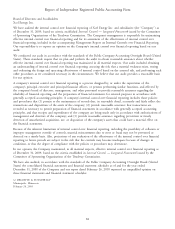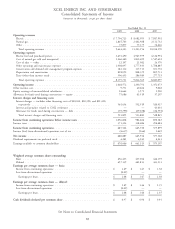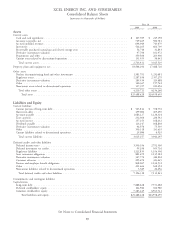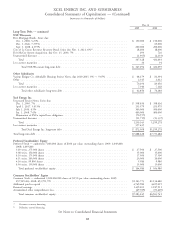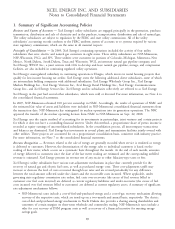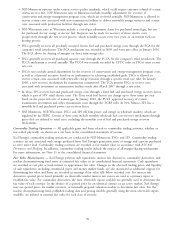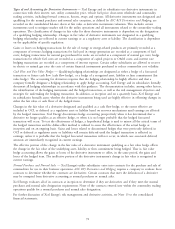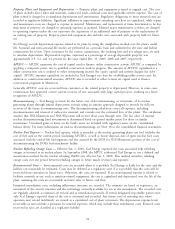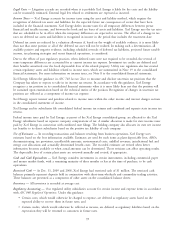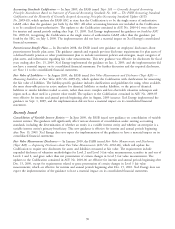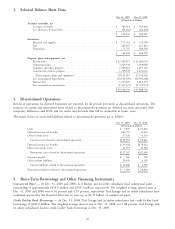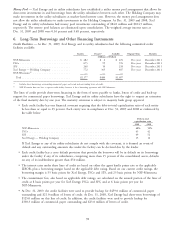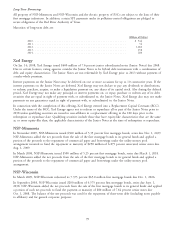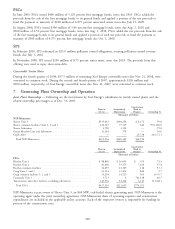Xcel Energy 2009 Annual Report Download - page 101
Download and view the complete annual report
Please find page 101 of the 2009 Xcel Energy annual report below. You can navigate through the pages in the report by either clicking on the pages listed below, or by using the keyword search tool below to find specific information within the annual report.Types of and Accounting for Derivative Instruments — Xcel Energy and its subsidiaries use derivative instruments in
connection with their interest rate, utility commodity price, vehicle fuel price, short-term wholesale and commodity
trading activities, including forward contracts, futures, swaps and options. All derivative instruments not designated and
qualifying for the normal purchases and normal sales exception, as defined by ASC 815 Derivatives and Hedging, are
recorded on the consolidated balance sheets at fair value as derivative instruments valuation. This includes certain
instruments used to mitigate market risk for the utility operations and all instruments related to the commodity trading
operations. The classification of changes in fair value for those derivative instruments is dependent on the designation
of a qualifying hedging relationship. Changes in fair value of derivative instruments not designated in a qualifying
hedging relationship are reflected in current earnings or as a regulatory asset or liability. The classification is dependent
on the applicability of specific regulation.
Gains or losses on hedging transactions for the sale of energy or energy-related products are primarily recorded as a
component of revenue; hedging transactions for fuel used in energy generation are recorded as a component of fuel
costs; hedging transactions for natural gas purchased for resale are recorded as a component of natural gas costs; hedge
transactions for vehicle fuel costs are recorded as a component of capital projects or O&M costs; and interest rate
hedging transactions are recorded as a component of interest expense. Certain utility subsidiaries are allowed to recover
in electric or natural gas rates the costs of certain financial instruments purchased to reduce commodity cost volatility.
Cash Flow and Fair Value Hedges — Qualifying hedging relationships are designated as either a hedge of a forecasted
transaction or future cash flow (cash flow hedge), or a hedge of a recognized asset, liability or firm commitment (fair
value hedge). The accounting for derivatives requires that the hedging relationship be highly effective and that a
company formally designate a hedging relationship to apply hedge accounting. Xcel Energy and its subsidiaries formally
document all hedging relationships in accordance with this guidance. The documentation includes, among other factors,
the identification of the hedging instrument and the hedged transaction, as well as the risk management objectives and
strategies for undertaking the hedging transaction. In addition, at inception and on a quarterly basis, Xcel Energy and
its subsidiaries formally assess whether the derivative instruments being used are highly effective in offsetting changes in
either the fair value or cash flows of the hedged items.
Changes in the fair value of a derivative designated and qualified as a cash flow hedge, to the extent effective are
included in OCI, or deferred as a regulatory asset or liability based on recovery mechanisms until earnings are affected
by the hedged transaction. Xcel Energy discontinues hedge accounting prospectively when it has determined that a
derivative no longer qualifies as an effective hedge, or when it is no longer probable that the hedged forecasted
transaction will occur. To test the effectiveness of hedges, a hypothetical hedge is used to mirror all the critical terms of
the hedged transaction and the dollar-offset method is utilized to assess the effectiveness of the actual hedge at
inception and on an ongoing basis. Gains and losses related to discontinued hedges that were previously deferred in
OCI or deferred as regulatory assets or liabilities will remain deferred until the hedged transaction is reflected in
earnings, unless it is probable that the hedged forecasted transaction will not occur, in which case associated deferred
amounts are immediately recognized in current earnings.
The effective portion of the change in the fair value of a derivative instrument qualifying as a fair value hedge offsets
the change in the fair value of the underlying asset, liability or firm commitment being hedged. That is, fair value
hedge accounting allows the gains or losses of the derivative instrument to offset, in the same period, the gains and
losses of the hedged item. The ineffective portion of the derivative instrument’s change in fair value is recognized in
current earnings.
Normal Purchases and Normal Sales — Xcel Energy’s utility subsidiaries enter into contracts for the purchase and sale of
commodities for use in their business operations. ASC 815 Derivatives and Hedging requires a company to evaluate these
contracts to determine whether the contracts are derivatives. Certain contracts that meet the definition of a derivative
may be exempted from derivative accounting as normal purchases or normal sales.
Xcel Energy evaluates all of its contracts at inception to determine if they are derivatives and if they meet the normal
purchases and normal sales designation requirements. None of the contracts entered into within the commodity trading
operations qualify for a normal purchases and normal sales designation.
For further discussion of Xcel Energy’s risk management and derivative activities, see Note 13 to the consolidated
financial statements.
91



